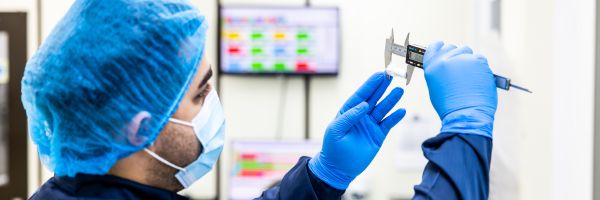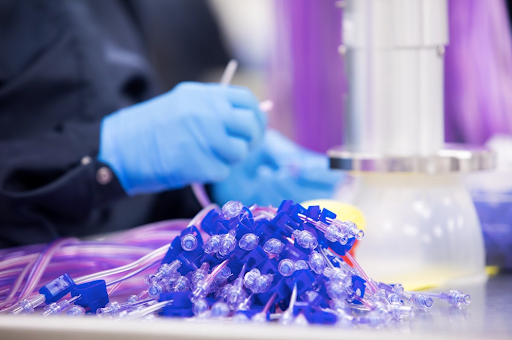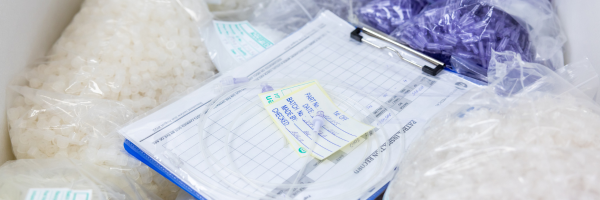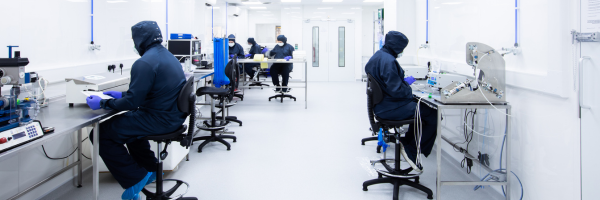
In the highly regulated world of medical device manufacturing, ensuring that each aspect of your production consistently meets specification is critical. A robust Medical Device Validation Plan plays a vital role in this process. This blog will explore the differences between production verification and production validation in the development and manufacturing of medical devices, and how both can be used to ensure our devices are of the highest quality.
What’s the Difference Between Production Verification and Production Validation?
Understanding the distinction between production verification and validation is essential for any medical device manufacturer.
Production Verification
Production verification ensures that the production process consistently produces products that meet the predefined specifications. It answers the question, “Did we make the right product?”.
Production verification of medical devices involves:
- Inspecting and testing products at various stages of the production process.
- Comparing production output to design specifications.
- Identifying and correcting deviations from the standard.
Production Validation
Production validation, on the other hand, confirms that the final products meet user needs and intended uses. It answers the question, “What is the process required to create the product right every time?”.
Production validation of medical devices involves:
Conducting performance testing challenging the production process variables.
Testing products from multiple batches to ensure they are the same.
Statistical analysis such as CPK (Process Capability Index) and Bell curves.
Both production verification and production validation are integral to maintaining high-quality standards in medical device manufacturing, and both should be used to ensure your production meets specification.
What Are Production Verification Best Practices?
To achieve effective production verification, manufacturers should adhere to several best practices:
- Clear specifications: Ensure that production specifications are well-defined and traceable. This clarity is essential for effective verification.
- Use data from the Validation process: The medical device validation phase will highlight processes that are statistically less stable. If they are high risk items, they should be part of your verification process.
- Early and continuous Verification: Begin verification activities early in the production process and continue them throughout. This helps identify and address issues promptly.
- Comprehensive documentation: Maintain detailed records of all verification activities, including test plans, protocols, and results. This documentation is vital for regulatory compliance.
- Use production inspection Accepted Quality Level (AQL): Use calculators to define how many products should be tested at each stage.
- Verification can be a sliding scale: As you gather more production data, increase or decrease your verification activities based on the failure rates.
What Are Production Validation Best Practices?
Similarly, effective production validation requires adherence to best practices, such as:
- Use the Validation V model: Define the project, then test and measure the results
- Use process indicators: Weights, lengths and widths being within specification can be good indicators that your process is running within tolerance, or that something is not.
- Challenge the process: Produce your product using multiple batches that are hot or cold, new and old.
- Real-world testing: Medical device validation should be carried out in conditions that closely mimic their intended environment. Is your production operating 24/7? Then your validation should be conducted during all these times, by all shifts.
- Iterative Validation: Be prepared to repeat medical device validation activities as the design evolves. Each iteration should refine and improve the product.
- Cross-functional teams: Involve diverse expertise in validation activities, including engineering, clinical, regulatory and user representatives.
Creating an Effective Production Verification and Validation Plan
An effective Production Verification and Validation (V&V) Plan is essential for ensuring that medical devices meet all of your requirements and standards. Here’s how to create one:
- Define objectives and scope: Clearly outline what the V&V Plan aims to achieve and the scope of activities. This includes specifying the devices, processes and requirements of the end device.
- Establish criteria for success: Determine the acceptance criteria for verification and validation activities. These criteria should be measurable and aligned with regulatory requirements as well as the performance specification of the device.
- Develop detailed protocols: Create detailed protocols for each verification and validation activity. These should include the methods, tools and procedures to be used, as well as roles and responsibilities.
- Plan for resources and timeline: Allocate the necessary resources, including personnel, equipment and time. Ensure that the plan is realistic and feasible within the project timeline.
- Incorporate risk management: Integrate risk management activities into the V&V Plan. Identify potential risks and define mitigation strategies to address them.
- Document and review: Maintain comprehensive documentation of the V&V Plan and its execution. Regularly review and update the plan to reflect changes in the design or regulatory landscape.
Incorporating Production Changes After Initial Verification and Validation
It’s common for production changes to occur after initial verification and validation. When this happens, it’s crucial to reassess and revalidate to ensure continued compliance and performance.
- Conduct an Impact Assessment: Evaluate the impact of production changes on the device’s functionality, safety and compliance. This assessment will determine the extent of re-verification and re-validation required.
- Update documentation: Revise all relevant documentation, including production specifications, verification protocols and validation reports, to reflect the changes.
- Repeat necessary activities: Perform additional verification and validation activities as needed to ensure that the modified device meets all requirements.
- Communicate with stakeholders: Keep all stakeholders informed of the changes and their implications. This includes regulatory bodies, users and internal teams.
Why Choose Meridian Medical Limited for Your Medical Device Manufacturing?
At Meridian Medical Limited, we bring extensive experience and expertise to every project. Our rigorous approach to production verification and validation ensures that your medical devices meet the highest standards of quality and safety. With a dedicated team of professionals and state-of-the-art facilities, we are well-equipped to handle all aspects of your manufacturing needs.
Whether you are looking to develop a new device or improve an existing one, our comprehensive services can help you achieve your goals. Contact us today to learn more about how we can support your medical device manufacturing needs.
By understanding and implementing robust production verification and validation processes, you can ensure that your medical devices are not only compliant with regulatory standards but also meet the highest quality and safety standards for end-users. Trust Meridian Medical Limited to guide you through this complex process with expertise and dedication.
To find out more about how Meridian Medical can help you with your medical device manufacture, get in touch today by filling out our online form or contacting us on 01903 732344 or info@meridian-medical.com

Author: Andrew Wootten, Quality and Regulatory Manager
Andrew Wootten has been at the forefront of Meridian Medical’s quality and regulatory functions for over a decade. With a career in quality management that began in 1989 and extensive experience in the medical device sector since 2002, Andrew is a seasoned expert. He holds a City and Guilds certificate in Quality Assurance, a diploma in Quality Management from BSI, and is a certified internal auditor for ISO 13485, ISO 9001, and ISO 14001. Andrew ensures our regulatory compliance and drives the company’s commitment to excellence in quality and safety, making him a trusted authority in the industry. His deep understanding of global regulatory challenges and unwavering dedication to quality assurance position him as a key figure in delivering safe, compliant and top-quality medical devices.



